The condition to consider for this to happen is a load beyond the rating of the supplies in question. Most severely, a short circuit. A short circuit need not be permanent and can even be a part of normal use: A motor, when starting, or a capacitor, when being charged from 0 V, looks like a short circuit, too.
To explain how a negative voltage can appear on one supply's output, let's use a diagram with some arrows. Supply A's output voltage shall be called VA, supply B's output VB, and the voltage across the load shall be called VL.
 Source
Source
With KVL:
\$V_A + V_B = V_L\$
This is true for normal operation, when we want to use, for example, two supplies with VA = VB = 12 V for a load that needs VL = 24 V:
\$12V + 12V = 24V\$
For a short circuit, VL = 0 V, and KVL still applies. Thus, \$V_A + V_B = 0\$ or
\$V_A = -V_B\$
If we want to avoid negative voltages on any of the two supplies, the only possible solution is
\$V_A = V_B = 0\$
However, because of \$V = R \cdot I\$, and because any real power supply has a non-zero internal resistance, this also means that no current must flow. Now, a power supply will try to deliver current. Since the current or power limit of the two supplies will not be exactly equal, the "stronger" supply will be able to maintain a small, positive output voltage, and the only way to solve the KVL equation is by back-feeding the other supply, with a negative voltage across its output.
